Cohort-Based Analysis of Foreign Residents’ Growth in Japan
Abstract
:1. Introduction
2. Methods
3. Data
3.1. Data Sources
3.2. Data Setting for NMF
4. Results and Discussion
4.1. Transition of Newly-Born Cohort
4.2. Pattern Extraction with NMF and Its Spatial Distribution
4.3. Discussion about the Supporting Policies for Foreign Residents
5. Conclusions
Author Contributions
Funding
Institutional Review Board Statement
Informed Consent Statement
Data Availability Statement
Conflicts of Interest
References
- Sato, M. From Foreign Workers to Minority Residents: Diversification of International Migration in Japan. Ritsumeikan Annu. Rev. Int. Stud. 2004, 3, 19–34. [Google Scholar]
- Statistics Bureau, Ministry of Internal Affairs and Communications(MIAC). Portal Site of Official Statistics of Japan Website. Available online: https://www.e-stat.go.jp/ (accessed on 1 January 2020).
- Toshihiro, M. COVID-19 and the Crisis in Japanese Immigration Policy. Available online: https://www.nippon.com/en/in-depth/d00572/ (accessed on 20 March 2022).
- Ministry of Justice. Investigation into cases of disappearance: Outline of the Results of the Project Team’s Investigation and Review into Operation of the Technical Training System. Available online: https://www.moj.go.jp/isa/content/930004344.pdf (accessed on 20 March 2022).
- Specified Skilled Worker Systems (Initiatives to Accept Foreign Nationals and for the Realization of Society of Harmonious Coexistence). Immigration Services Agency of Japan. Available online: https://www.moj.go.jp/isa/content/001335263.pdf (accessed on 15 May 2022).
- Saito, J. Historical Background of the Japanese Restrictive Immigration Policy. Japanese Economy Update, Japan Center for Economic Research, 15 August 2022. Available online: https://www.jcer.or.jp/english/historical-background-of-the-japanese-restrictive-immigration-policy (accessed on 20 March 2022).
- Oo, S.; Tsukai, M. Long-Term Impact of Interregional Migrants on Population Prediction. Sustainability 2022, 14, 6580. [Google Scholar] [CrossRef]
- Sekiguchi, T.; Hayashi, N.; Sugino, H.; Terada, Y. The Effects of Differences in Individual Characteristics and Regional Living Environments on the Motivation to Immigrate to Hometowns: A Decision Tree Analysis. Appl. Sci. 2019, 9, 2748. [Google Scholar] [CrossRef]
- Analytical Report of the Foreign Residents Survey—Revised Edition; Center for Human Rights Education and Training: Tokyo, Japan, 2017.
- Annual Report on the Labor Force Survey; Statistic Bureau of Japan: Tokyo, Japan, 2020.
- Yoshida, M. Women, Citizenship, and Migration: The Resettlement of Vietnamese Refugees in Australia and Japan; Nakanishiya Shuppan: Kyoto, Japan, 2011. [Google Scholar]
- Ishikawa, Y. (Ed.) International Migrants in Japan: Contributions Inan Era of Population Decline; Trans Pacific Press: Tokyo, Japan, 2015. [Google Scholar]
- Matsutani, A. How Do They Live? Nihon Keizai Shinbun Shuppansha: Tokyo, Japan, 2007. [Google Scholar]
- Ono, G. Accepting Foreign Workers Spoils Japan; Yosensha: Tokyo, Japan, 2008. [Google Scholar]
- Menju, T. Dramatic Decrease of Population: Japan Needs Immigrants; Shinchosha: Tokyo, Japan, 2011. [Google Scholar]
- Kitawaki, Y. (Ed.) Design of “Open Japan”: Acceptance of Migrants and Social Integration of Them into Japanese Society; Koko Shuppan: Tokyo, Japan, 2011. [Google Scholar]
- Sakanaka, H. Population Collapse and Immigration Revolution: Immigrants State Declaration; Nihon Kajo Shuppan: Tokyo, Japan, 2012. [Google Scholar]
- Mitsuhashi, T. Immigration Is Ruinous to Japan: A Country for the Japanese Will Disappear! Tokuma Shoten: Tokyo, Japan, 2014. [Google Scholar]
- Hugo, G.; Morén-Alegret, R. International migration to non-metropolitan areas of high income countries: Editorial introduction. Popul. Space Place 2008, 14, 473–477. [Google Scholar] [CrossRef]
- Wulff, M.; Carter, T.; Vineberg, R.; Ward, S. Attracting New Arrivals to Smaller Cities and Rural Communities: Findings from Australia, Canada and New Zealand. J. Int. Migr. Integr. 2008, 9, 119–124. [Google Scholar] [CrossRef]
- Stillwell, J.; Hussain, S. Ethnic internal migration in England and Wales: Spatial analysis using a district classification framework. In Ethnicity and Integration: Understanding Population Trends and Processes; Springer: London, UK, 2010; Volume 3, pp. 105–132. [Google Scholar]
- Collantes, F.; Pinilla, V.; Sáez, L.A.; Silvestre, J. Reducing Depopulation in Rural Spain: The Impact of Immigration. Popul. Space Place 2014, 20, 606–621. [Google Scholar] [CrossRef]
- Sassen, K. Notes on the Incorporation of Third World Women into Wage-Labor Through Immigration and Off-Shore Production. Int. Migr. Rev. 1984, 18, 1144–1167. [Google Scholar] [CrossRef]
- Frey, C.B. New job creation in the UK: Which regions will benefit most from the digital revolution. In PwC UK Economic Outlook; PwC UK: St Albans, UK, 2015. [Google Scholar]
- Keyes, K.M.; Li, G. Age–Period–Cohort Modeling. In Injury Research; Li, G., Baker, S., Eds.; Springer: Boston, MA, USA, 2012. [Google Scholar] [CrossRef]
- Dowell, M.; Lee, H.; Simmons, P. Cohort Transitions and Age Group Analysis of Millennial Homeownership Demand: Understanding Trajectories of Recovery Following the Great Recession. Fannie Mae Working Paper, 2018. Available online: https://www.fanniemae.com/media/19341/display (accessed on 20 March 2022).
- Eren, F. Does the Asian property market work for sustainable urban developments. In Sustainable Cities in Asia; Caprotti, F., Yu, L., Eds.; Routledge: London, UK, 2018; pp. 32–47. [Google Scholar] [CrossRef]
- Suykens, J.A.K.; Signoretto, M.; Argyriou, A. (Eds.) Regularization, Optimization, Kernels, and Support Vector Machines, 1st ed.; Chapman and Hall/CRC: Boca Raton, FL, USA, 2014. [Google Scholar] [CrossRef]
- Hamamoto, R.; Takasawa, K.; Machino, H.; Kobayashi, K.; Takahashi, S.; Bolatkan, A.; Shinkai, N.; Sakai, A.; Aoyama, R.; Yamada, M.; et al. Application of non-negative matrix factorization in oncology: One approach for establishing precision medicine. Brief. Bioinform. 2022, 23, bbac246. [Google Scholar] [CrossRef] [PubMed]
- Alghamdi, N.S.; Taher, F.; Kandil, H.; Sharafeldeen, A.; Elnakib, A.; Soliman, A.; ElNakieb, Y.; Mahmoud, A.; Ghazal, M.; El-Baz, A. Segmentation of Infant Brain Using Nonnegative Matrix Factorization. Appl. Sci. 2022, 12, 5377. [Google Scholar] [CrossRef]
- Devarajan, K. Nonnegative Matrix Factorization: An Analytical and Interpretive Tool in Computational Biology. PLoS Comput. Biol. 2008, 4, e1000029. [Google Scholar] [CrossRef] [PubMed]
- Huffman, M.; Davis, A.; Park, J.; Curry, J. Identifying Population Movements with Non-Negative Matrix Factorization from Wi-Fi User Counts in Smart and Connected Cities. arXiv 2021, arXiv:2111.10459. [Google Scholar]
- Yang, H.; Seoighe, C. Impact of the Choice of Normalization Method on Molecular Cancer Class Discovery Using Nonnegative Matrix Factorization. PLoS ONE 2016, 11, e0164880. [Google Scholar] [CrossRef] [PubMed]
- Paatero, P.; Tapper, U. Positive matrix factorization: A non-negative factor model with optimal utilization of error estimates of data values. Environmetrics 1994, 5, 111–126. [Google Scholar] [CrossRef]
- Lee, D.D.; Seung, H.S. Learning the parts of objects by non-negative matrix factorization. Nature 1999, 401, 788–791. [Google Scholar] [CrossRef] [PubMed]
- Do, C.X.; Tsukai, M.; Fujiwara, A. Data quality analysis of interregional travel demand: Extracting travel patterns using matrix decomposition. Asian Transp. Stud. 2020, 6, 100018. [Google Scholar] [CrossRef]
- Brunet, J.-P.; Tamayo, P.; Golub, T.R.; Mesirov, J.P. Metagenes and molecular pattern discovery using matrix factorization. Proc. Natl. Acad. Sci. USA 2004, 101, 4164–4169. [Google Scholar] [CrossRef] [PubMed] [Green Version]
- Ministry of Justice. Report of Major Policies Related to Immigration Control Administration (Part 2). Available online: https://www.moj.go.jp/isa/content/930003771.pdf (accessed on 25 January 2023).
- Tohoku Bureau of Economy, Trade, and Industry. Economic Overview Of Tohoku Region. Available online: https://www.tohoku.meti.go.jp/s_kokusai/pdf/en2021.pdf (accessed on 25 January 2023).
- Chugoku Bureau of Economy, Trade, and Industry. The Outline of Chugoku Region in Japan. Available online: https://www.chugoku.meti.go.jp/policy/seisaku/glocal_pt/pdf/TheOutlineOfChugokuRegionInJapan_English.pdf (accessed on 25 January 2023).
- Kyushu Bureau of Economy, Trade, and Industry. Business and Investment Environment in Kyushu. Available online: https://www.kyushu.meti.go.jp/seisaku/kokusai/toushi/data/biz_env_en.pdf (accessed on 25 January 2023).
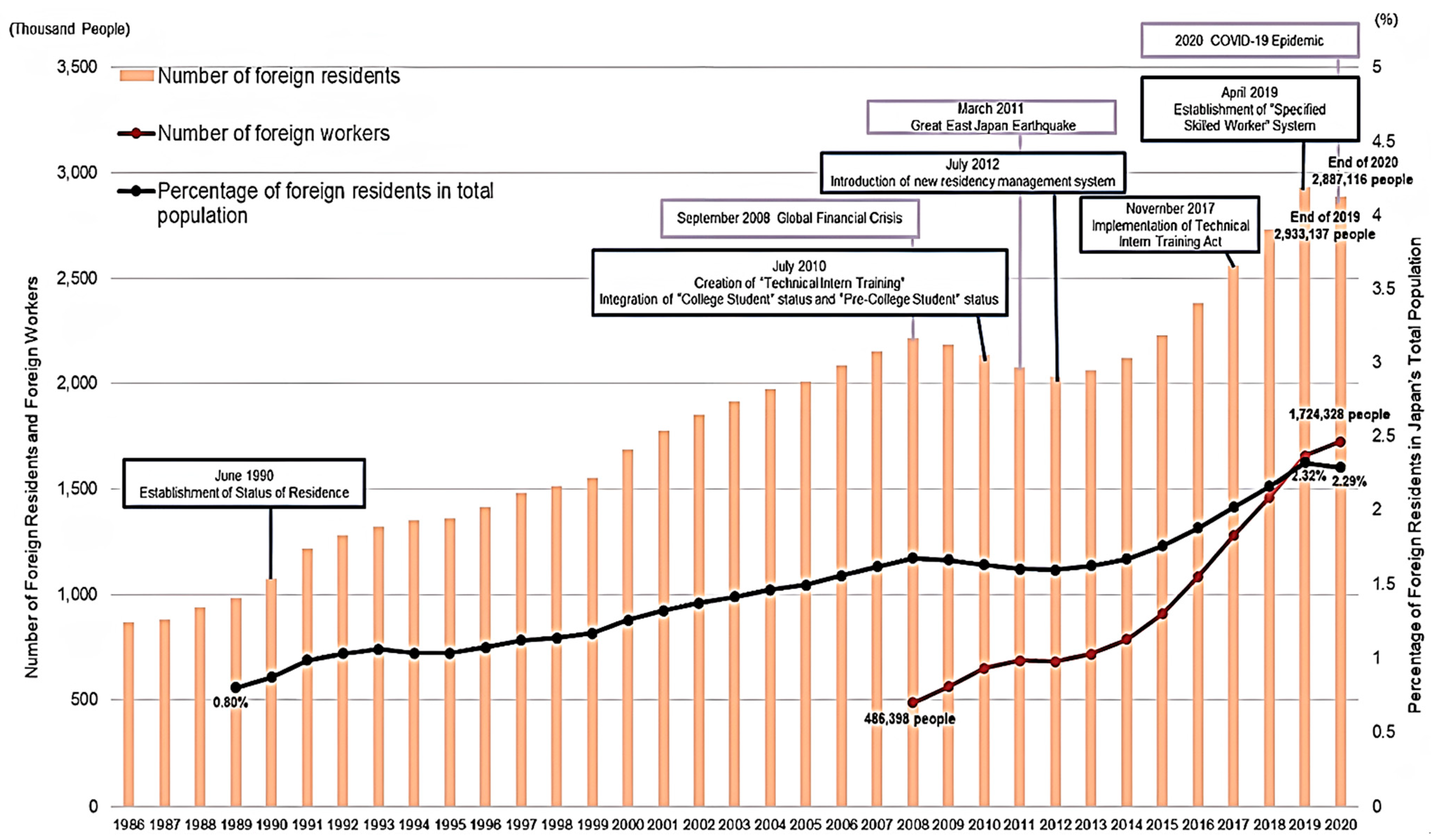
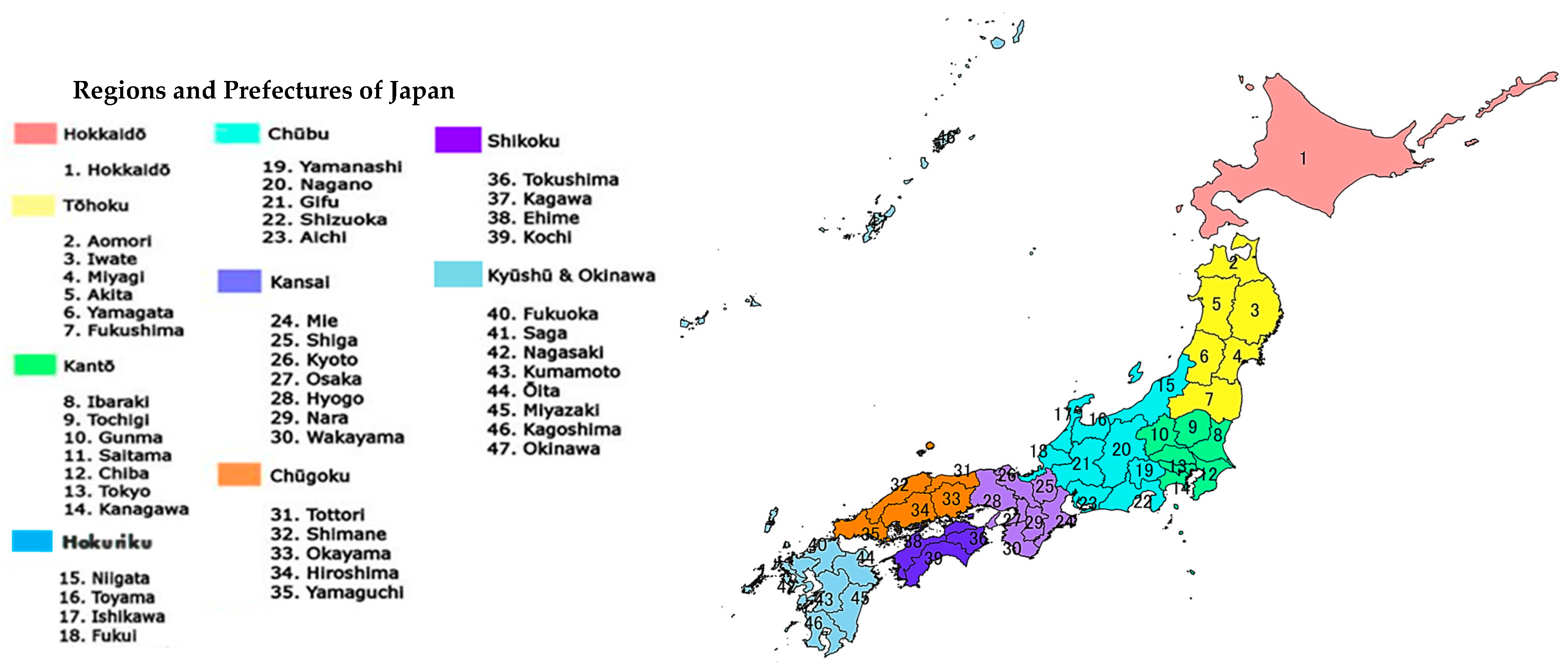
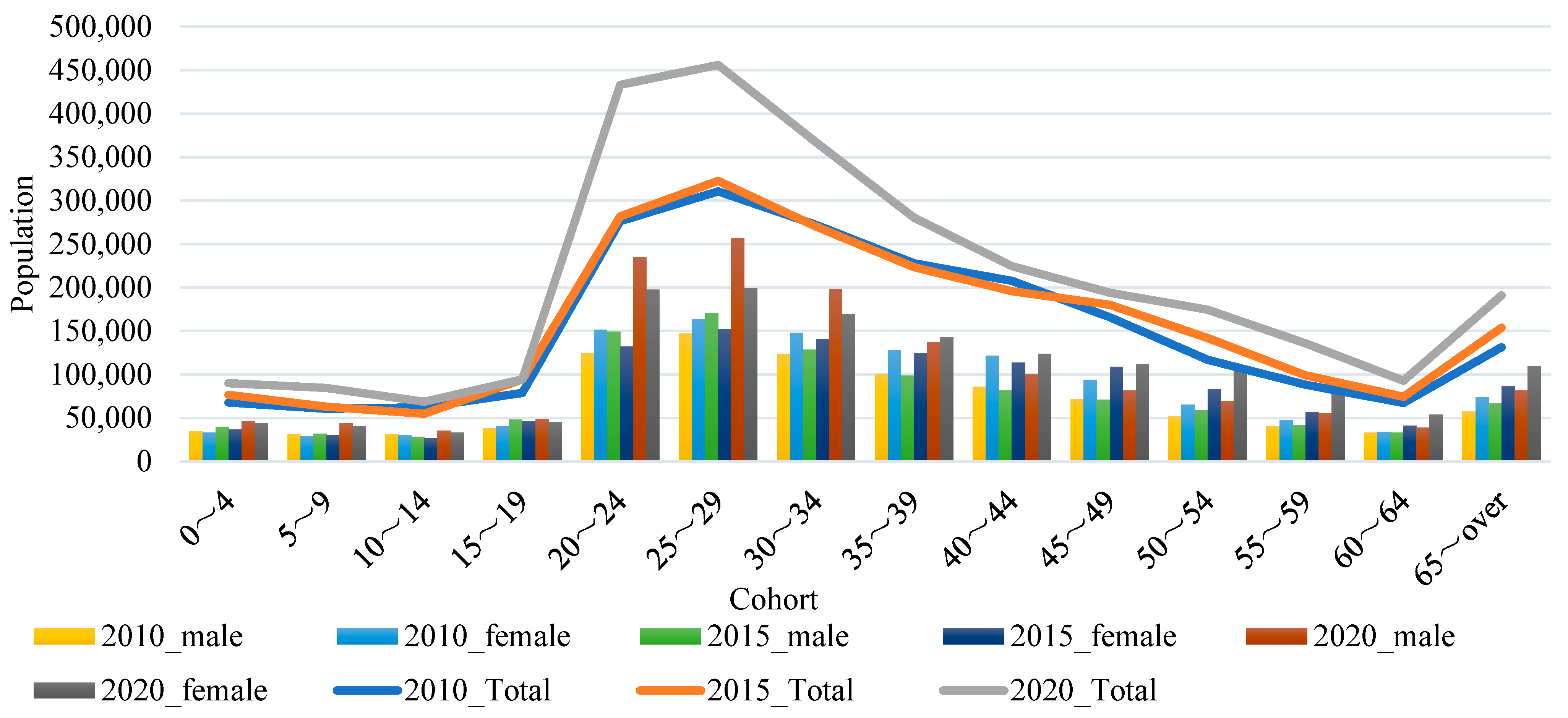
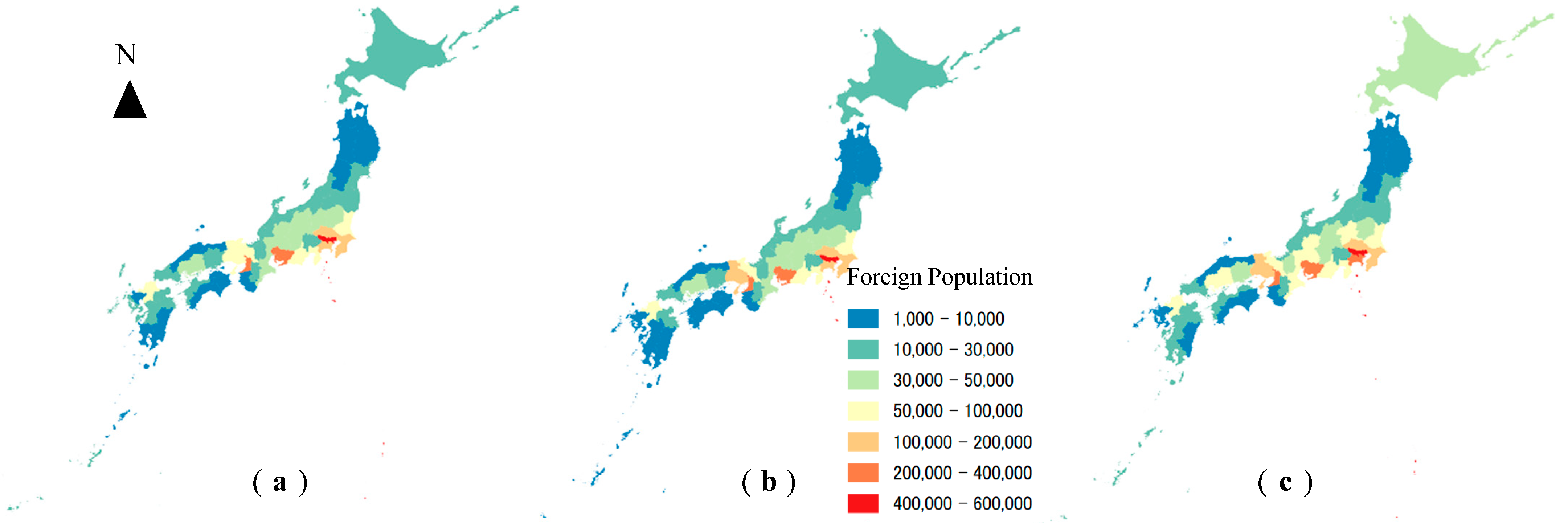
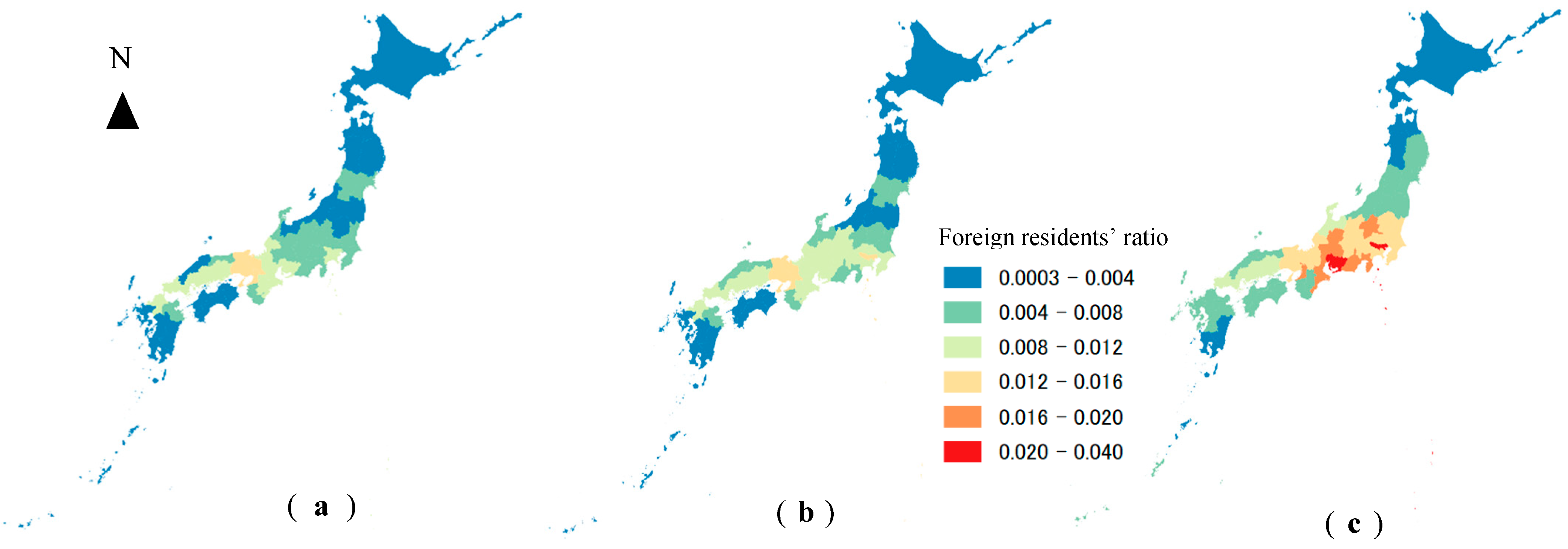
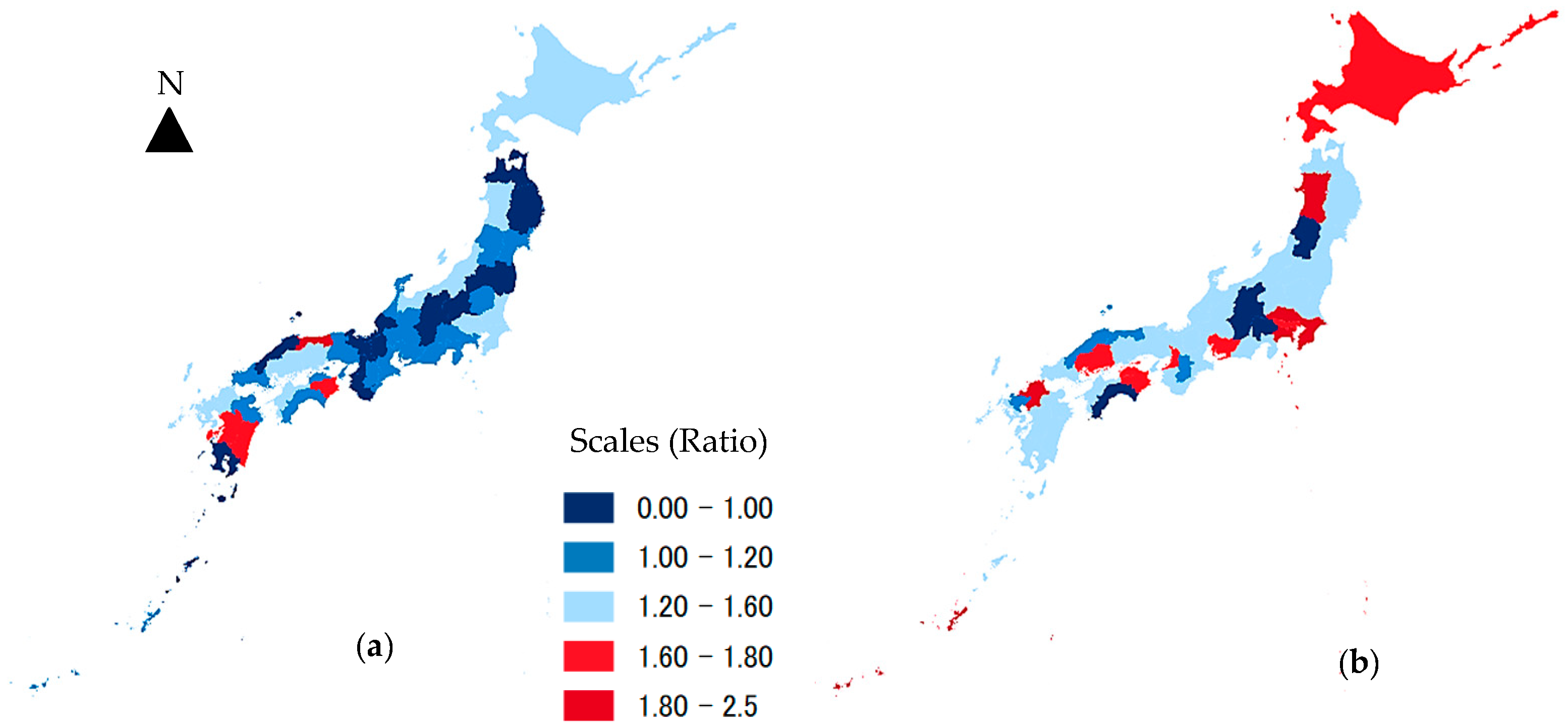


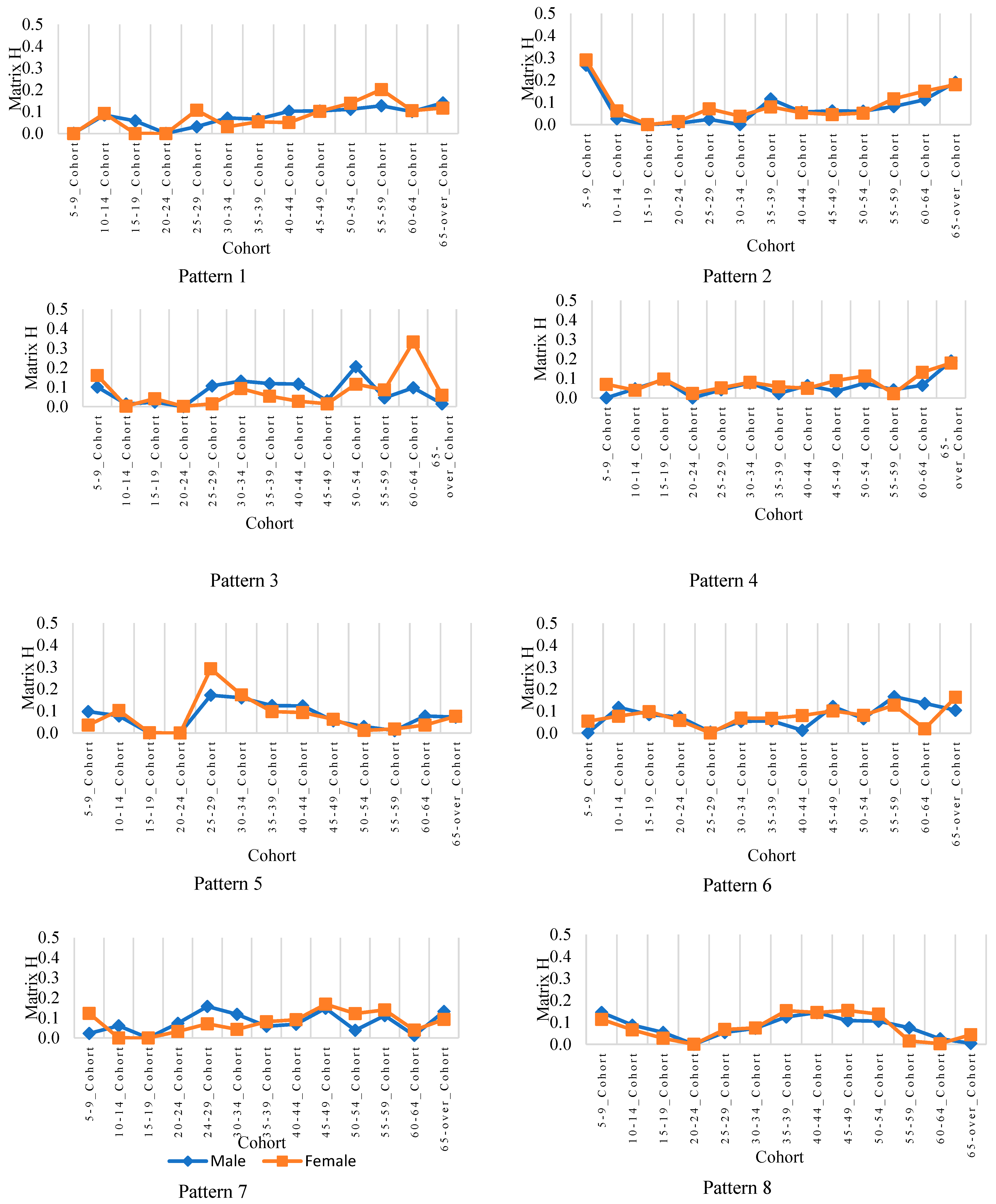
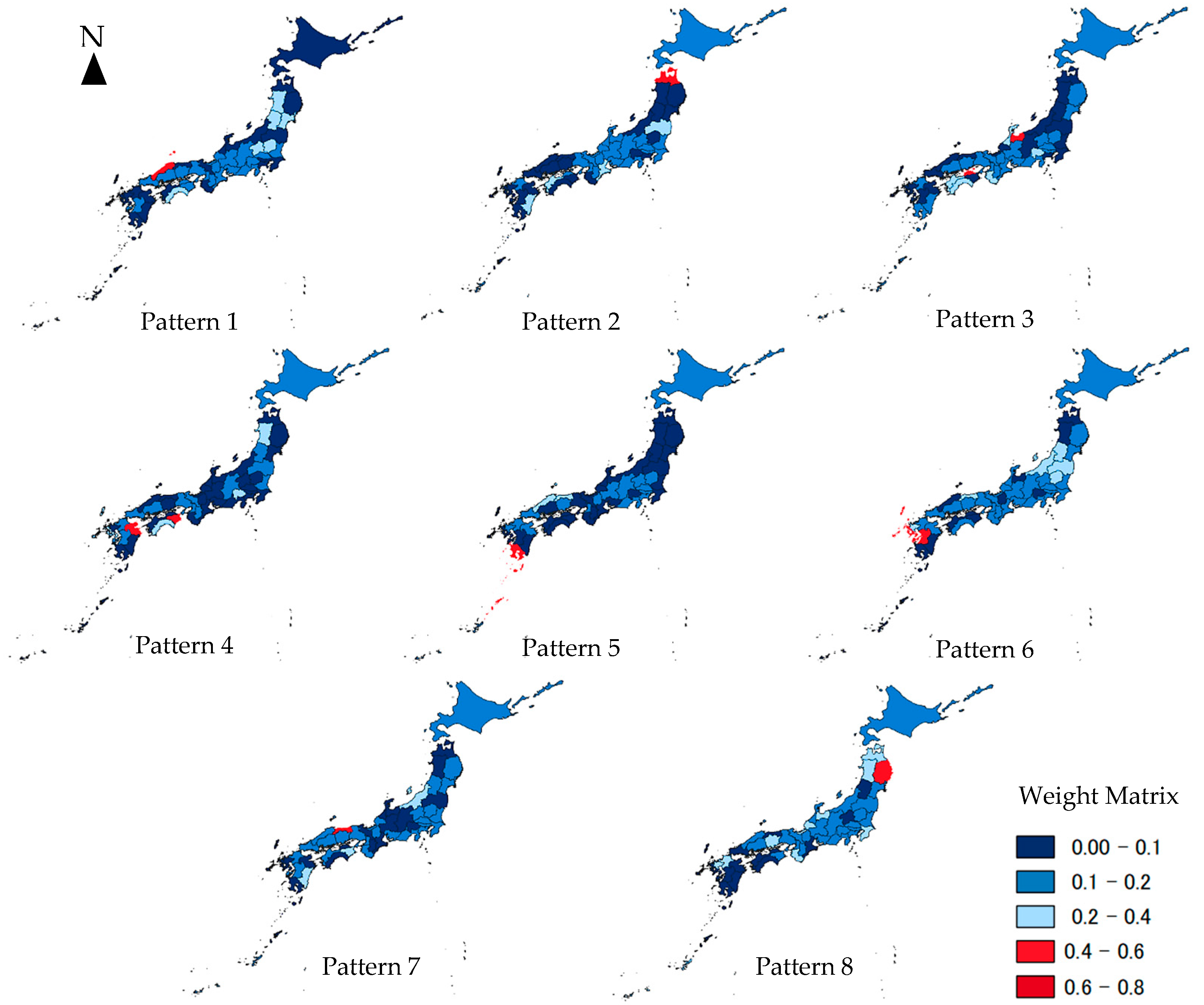
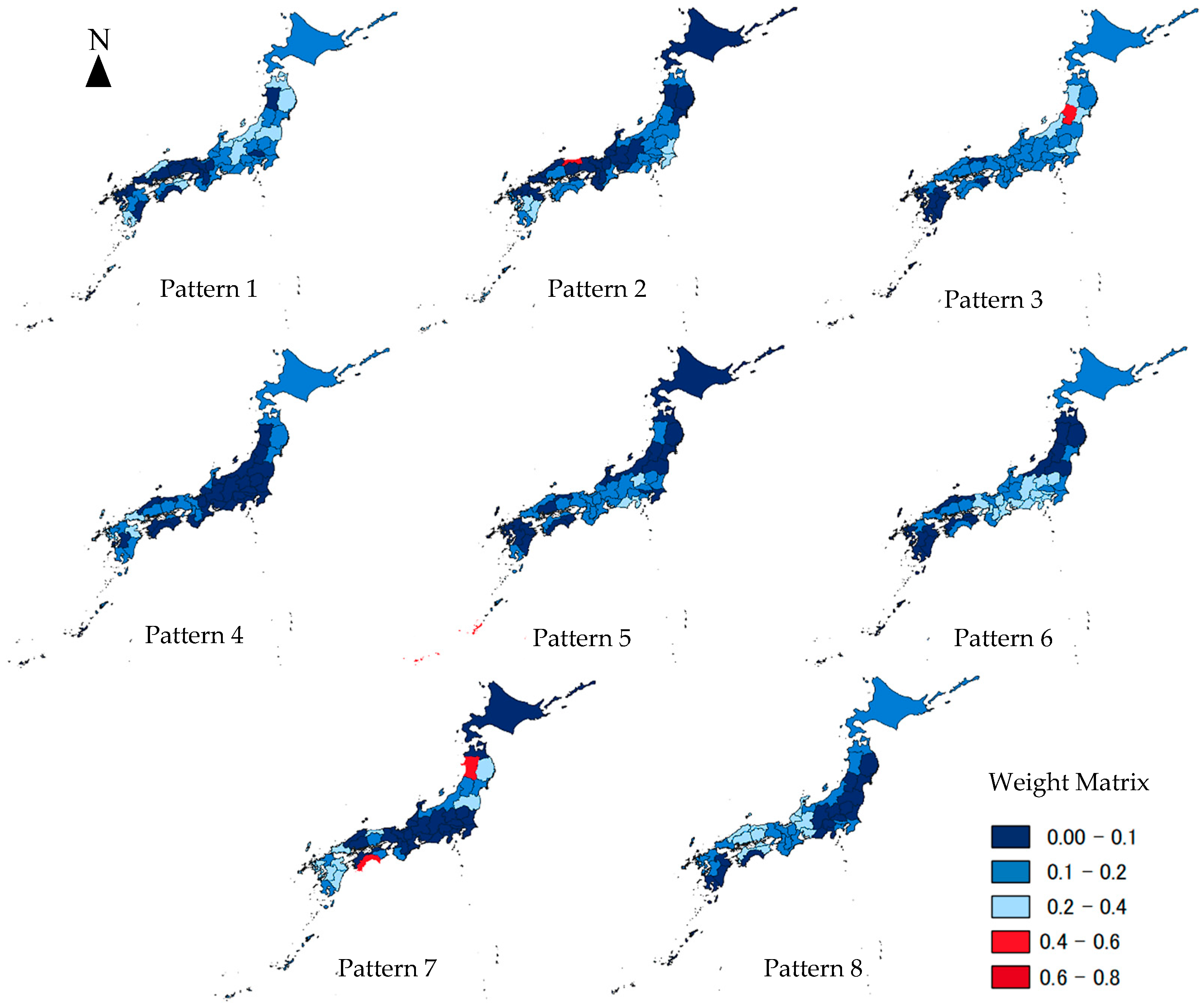
| Prefecture Number | 2010 to 2015 | 2015 to 2020 | ||||||||||||||
|---|---|---|---|---|---|---|---|---|---|---|---|---|---|---|---|---|
| Male | Female | Male | Female | |||||||||||||
| C | Y | M | E | C | Y | M | E | C | Y | M | E | C | Y | M | E | |
| 1 | 0.88 | 0.81 | 1.01 | 1.42 | 0.87 | 0.74 | 0.94 | 1.45 | 0.91 | 0.77 | 1.25 | 1.60 | 0.91 | 1.09 | 1.31 | 1.45 |
| 2 | 0.88 | 0.78 | 0.90 | 1.47 | 0.96 | 0.75 | 0.86 | 1.45 | 0.88 | 1.00 | 1.17 | 1.59 | 0.60 | 0.99 | 1.34 | 1.43 |
| 3 | 1.17 | 0.73 | 0.91 | 1.46 | 0.50 | 0.62 | 0.96 | 1.39 | 0.74 | 0.90 | 1.22 | 1.47 | 0.62 | 0.87 | 1.53 | 1.43 |
| 4 | 0.75 | 0.84 | 1.00 | 1.48 | 0.65 | 0.83 | 0.92 | 1.59 | 0.85 | 0.91 | 1.29 | 1.60 | 0.89 | 0.86 | 1.37 | 1.42 |
| 5 | 0.67 | 1.02 | 0.85 | 1.31 | 0.10 | 1.04 | 0.84 | 1.47 | 0.72 | 1.04 | 1.11 | 1.63 | 0.88 | 0.75 | 1.51 | 1.44 |
| 6 | 0.71 | 0.90 | 1.07 | 1.33 | 0.61 | 0.99 | 0.82 | 1.43 | 0.75 | 0.99 | 1.30 | 1.67 | 0.82 | 0.68 | 1.41 | 1.43 |
| 7 | 0.74 | 0.92 | 1.00 | 1.31 | 1.04 | 0.78 | 0.89 | 1.47 | 0.76 | 0.91 | 1.20 | 1.82 | 0.75 | 0.73 | 1.42 | 1.60 |
| 8 | 0.76 | 0.88 | 1.01 | 1.35 | 0.75 | 0.87 | 0.93 | 1.5 | 0.97 | 0.76 | 1.42 | 1.95 | 0.92 | 0.72 | 1.41 | 1.91 |
| 9 | 0.84 | 0.79 | 1.00 | 1.44 | 0.84 | 0.89 | 0.90 | 1.45 | 0.93 | 0.80 | 1.33 | 1.91 | 0.91 | 0.73 | 1.37 | 1.92 |
| 10 | 0.83 | 0.85 | 0.97 | 1.36 | 0.98 | 0.76 | 0.92 | 1.43 | 0.94 | 0.82 | 1.31 | 1.81 | 0.94 | 0.74 | 1.39 | 1.97 |
| 11 | 0.92 | 0.74 | 1.08 | 1.38 | 0.92 | 0.71 | 0.99 | 1.5 | 0.97 | 0.75 | 1.36 | 2.00 | 0.96 | 0.70 | 1.40 | 1.76 |
| 12 | 0.94 | 0.69 | 1.04 | 1.40 | 0.83 | 0.73 | 0.95 | 1.54 | 0.99 | 0.73 | 1.37 | 1.93 | 0.95 | 0.68 | 1.39 | 1.75 |
| 13 | 0.86 | 0.77 | 1.13 | 1.38 | 0.87 | 0.75 | 1.08 | 1.39 | 0.97 | 0.73 | 1.36 | 1.73 | 0.93 | 0.76 | 1.37 | 1.57 |
| 14 | 0.85 | 0.75 | 1.04 | 1.38 | 0.89 | 0.71 | 1.00 | 1.39 | 0.96 | 0.72 | 1.31 | 1.83 | 0.93 | 0.69 | 1.33 | 1.65 |
| 15 | 1.18 | 0.62 | 1.02 | 1.41 | 0.95 | 0.70 | 0.89 | 1.54 | 0.93 | 0.81 | 1.31 | 1.63 | 0.86 | 0.71 | 1.49 | 1.45 |
| 16 | 1.26 | 0.68 | 0.92 | 1.47 | 0.62 | 0.68 | 0.90 | 1.3 | 0.99 | 0.77 | 1.39 | 1.74 | 0.95 | 0.78 | 1.48 | 1.61 |
| 17 | 1.04 | 0.75 | 0.97 | 1.29 | 0.67 | 0.77 | 0.87 | 1.3 | 0.93 | 0.93 | 1.34 | 1.59 | 0.95 | 0.94 | 1.35 | 1.47 |
| 18 | 0.79 | 0.83 | 0.88 | 1.28 | 0.66 | 0.74 | 0.89 | 1.29 | 0.91 | 0.76 | 1.25 | 1.47 | 0.81 | 0.82 | 1.32 | 1.42 |
| 19 | 0.94 | 1.28 | 1.03 | 1.46 | 0.79 | 1.05 | 0.95 | 1.52 | 0.95 | 0.83 | 1.32 | 1.80 | 0.86 | 0.76 | 1.35 | 1.90 |
| 20 | 0.60 | 0.95 | 0.95 | 1.29 | 0.73 | 0.93 | 0.92 | 1.37 | 0.98 | 0.81 | 1.26 | 1.88 | 0.91 | 0.74 | 1.35 | 1.84 |
| 21 | 0.77 | 0.81 | 0.90 | 1.32 | 0.78 | 0.88 | 0.88 | 1.25 | 0.95 | 0.83 | 1.29 | 1.75 | 0.89 | 0.77 | 1.45 | 1.53 |
| 22 | 0.93 | 0.78 | 0.97 | 1.31 | 0.90 | 0.75 | 0.93 | 1.36 | 0.91 | 0.79 | 1.32 | 1.92 | 0.91 | 0.71 | 1.39 | 1.93 |
| 23 | 0.80 | 0.78 | 0.97 | 1.30 | 0.77 | 0.80 | 0.94 | 1.27 | 0.96 | 0.75 | 1.28 | 1.60 | 0.95 | 0.74 | 1.33 | 1.45 |
| 24 | 0.74 | 0.87 | 0.97 | 1.31 | 0.79 | 0.83 | 0.88 | 1.32 | 0.96 | 0.75 | 1.32 | 1.85 | 0.93 | 0.82 | 1.33 | 1.65 |
| 25 | 0.69 | 0.91 | 0.94 | 1.30 | 0.79 | 0.81 | 0.90 | 1.31 | 0.95 | 0.81 | 1.23 | 1.69 | 0.94 | 0.75 | 1.28 | 1.47 |
| 26 | 0.78 | 0.85 | 0.95 | 1.32 | 0.74 | 0.88 | 0.92 | 1.26 | 0.78 | 0.81 | 1.08 | 1.42 | 0.77 | 0.87 | 1.09 | 1.32 |
| 27 | 0.75 | 0.82 | 0.92 | 1.34 | 0.74 | 0.79 | 0.90 | 1.29 | 0.83 | 0.80 | 1.08 | 1.48 | 0.81 | 0.79 | 1.09 | 1.36 |
| 28 | 0.75 | 0.87 | 0.92 | 1.35 | 0.77 | 0.81 | 0.90 | 1.3 | 0.83 | 0.82 | 1.06 | 1.51 | 0.83 | 0.83 | 1.09 | 1.37 |
| 29 | 0.69 | 0.90 | 0.93 | 1.31 | 0.58 | 0.82 | 0.93 | 1.29 | 0.85 | 0.79 | 1.13 | 1.54 | 0.91 | 0.82 | 1.15 | 1.43 |
| 30 | 1.41 | 0.57 | 0.97 | 1.35 | 0.74 | 0.74 | 0.90 | 1.32 | 0.76 | 0.85 | 1.10 | 1.46 | 0.70 | 0.70 | 1.19 | 1.39 |
| 31 | 1.36 | 0.74 | 0.96 | 1.33 | 1.11 | 0.67 | 1.02 | 1.32 | 1.21 | 0.81 | 1.20 | 1.42 | 0.86 | 0.81 | 1.39 | 1.33 |
| 32 | 0.61 | 0.86 | 0.97 | 1.34 | 0.85 | 1.31 | 0.89 | 1.34 | 0.94 | 0.67 | 1.31 | 1.49 | 0.70 | 0.74 | 1.59 | 1.34 |
| 33 | 0.85 | 0.77 | 0.96 | 1.34 | 0.79 | 0.77 | 0.93 | 1.3 | 0.91 | 1.01 | 1.20 | 1.47 | 0.89 | 0.87 | 1.32 | 1.34 |
| 34 | 0.87 | 0.81 | 0.94 | 1.34 | 0.81 | 0.83 | 0.90 | 1.28 | 0.97 | 0.84 | 1.24 | 1.48 | 0.90 | 0.83 | 1.26 | 1.41 |
| 35 | 0.58 | 0.94 | 0.88 | 1.39 | 0.75 | 0.90 | 0.88 | 1.29 | 0.76 | 1.00 | 1.03 | 1.41 | 0.80 | 1.05 | 1.08 | 1.33 |
| 36 | 0.50 | 0.79 | 1.04 | 1.47 | 0.11 | 1.05 | 1.02 | 1.56 | 1.13 | 0.75 | 1.47 | 1.68 | 1.00 | 0.79 | 1.76 | 1.64 |
| 37 | 1.11 | 0.92 | 1.01 | 1.33 | 0.67 | 0.84 | 1.02 | 1.39 | 0.84 | 0.89 | 1.36 | 1.90 | 0.92 | 1.00 | 1.42 | 1.62 |
| 38 | 1.06 | 0.80 | 1.03 | 1.36 | 1.30 | 0.93 | 0.92 | 1.36 | 0.99 | 0.77 | 1.42 | 1.63 | 0.87 | 0.89 | 1.48 | 1.39 |
| 39 | 0.80 | 1.24 | 0.94 | 1.28 | 0.52 | 1.08 | 0.95 | 1.38 | 0.56 | 1.22 | 1.25 | 1.64 | 0.70 | 0.88 | 1.42 | 1.54 |
| 40 | 0.89 | 0.74 | 0.98 | 1.41 | 0.80 | 0.81 | 0.95 | 1.32 | 0.89 | 1.02 | 1.20 | 1.46 | 0.85 | 0.94 | 1.24 | 1.33 |
| 41 | 0.82 | 0.70 | 0.98 | 1.35 | 1.00 | 0.89 | 0.97 | 1.25 | 0.90 | 1.12 | 1.21 | 1.58 | 0.86 | 1.00 | 1.41 | 1.40 |
| 42 | 0.72 | 0.84 | 1.00 | 1.56 | 1.01 | 1.16 | 1.04 | 1.25 | 1.07 | 1.04 | 1.19 | 1.86 | 0.83 | 1.04 | 1.35 | 1.65 |
| 43 | 0.58 | 0.94 | 1.05 | 1.37 | 0.77 | 0.84 | 0.98 | 1.43 | 1.02 | 0.87 | 1.28 | 2.07 | 0.88 | 0.79 | 1.49 | 1.82 |
| 44 | 0.68 | 1.48 | 1.01 | 1.42 | 0.84 | 1.57 | 0.90 | 1.35 | 0.80 | 1.30 | 1.26 | 1.52 | 0.72 | 1.45 | 1.33 | 1.35 |
| 45 | 0.93 | 1.01 | 1.11 | 1.22 | 0.96 | 0.70 | 1.12 | 1.36 | 0.83 | 1.12 | 1.27 | 1.80 | 0.83 | 0.88 | 1.42 | 1.55 |
| 46 | 0.80 | 0.81 | 1.21 | 1.36 | 1.33 | 0.55 | 1.08 | 1.51 | 0.85 | 0.83 | 1.23 | 1.95 | 0.81 | 1.04 | 1.55 | 1.98 |
| 47 | 1.18 | 0.56 | 1.17 | 1.29 | 1.14 | 0.67 | 1.25 | 1.79 | 1.05 | 0.79 | 1.17 | 1.95 | 0.91 | 0.73 | 1.28 | 1.99 |
| Region | Prefecture | Foreign Population Growth Rate | Newly Born Cohort Transition | Change in Foreign Residents Share | Patterns by NMF from 2010 to 2015 | Patterns by NMF from 2015 to 2020 |
|---|---|---|---|---|---|---|
| Hokkaido | 1. Hokkaido | ▼ | ▬ | ▼ | ||
| Tohoku | 2. Aomori | ▼ | ▬ | ▼ | 2 15–19 cohort (f) 8 50–over cohorts (f) | 5 25–29 cohorts (m,f) |
| 3. Iwate | ▼ | ▼ | ▬ | 8 50–over cohorts (f) | 1 Average | |
| 4. Miyagi | ▬ | ▬ | ▬ | 3 25 to 49 cohorts (m) 3 60–64 cohort (f) | ||
| 5. Akita | ▬ | ▼ | ▼ | 1 20–24 cohort (m,f) 4 25–29 cohort (f) 8 50–over cohorts (f) | 7 25 to 34 cohorts (m) 3 25 to 49 cohorts (m) 7 45–59 cohorts (f) 3 60–64 cohort (f) | |
| 6. Yamagata | ▬ | ▬ | ▼ | 1 20–24 cohort (m,f) | 3 25 to 49 cohorts (m) 3 60–64 cohort (f) | |
| 7. Fukushima | ▼ | ▬ | ▼ | 6 10–14 cohort (f) 2 15–19 cohort (f) | ||
| Kanto | 8. Ibaraki | ▲ | ▬ | ▲ | 3 25 to 49 cohorts (m) 3 60–64 cohort (f) | |
| 9. Tochigi | ▬ | ▼ | ▲ | 1 20–24 cohort (m,f) | 4 60–over cohorts (m,f) | |
| 10. Gunma | ▲ | ▲ | ▲ | 4 60–over cohorts (m,f) | ||
| 11. Saitama | ▲ | ▲ | ▬ | |||
| 12. Chiba | ▲ | ▲ | ▬ | 2 5–9 cohort (m,f) | ||
| 13. Tokyo | ▲ | ▲ | ▲ | |||
| 14. Kanagawa | ▲ | ▲ | ▬ | 6 55–over cohorts (m,f) | ||
| Hokuriku | 15. Niigata | ▬ | ▬ | ▬ | 6 10–14 cohort (f) 7 45–49 cohort (f) | 3 25 to 49 cohorts (m) 3 60–64 cohort (f) |
| 16. Toyama | ▼ | ▬ | ▬ | 3 Average, Elderly 8 50–over cohorts (f) | ||
| 17. Ishikawa | ▬ | ▬ | ▬ | 3 Average, Elderly | ||
| 18. Fukui | ▬ | ▬ | ▬ | 8 5–9 cohort(m,f) 8 35 to 54 cohorts (m,f) | ||
| Chubu | 19. Yamanashi | ▬ | ▼ | ▲ | 4 25–29 cohort (f) | 6 55–over cohorts (m,f) |
| 20. Nagano | ▬ | ▬ | ▲ | |||
| 21. Gifu | ▲ | ▬ | ▲ | |||
| 22. Shizuoka | ▲ | ▲ | ▲ | 4 60–over cohorts (m,f) | ||
| 23. Aichi | ▲ | ▲ | ▲ | 6 55–over cohorts (m,f) | ||
| Kansai | 24. Mie | ▲ | ▬ | ▲ | 2 15–19 cohort (f) | |
| 25. Shiga | ▬ | ▬ | ▬ | 6 55–over cohorts (m,f) | ||
| 26. Kyoto | ▬ | ▬ | ▬ | |||
| 27. Osaka | ▬ | ▲ | ▬ | 6 55–over cohorts (m,f) | ||
| 28. Hyogo | ▬ | ▲ | ▬ | |||
| 29. Nara | ▬ | ▬ | ▬ | |||
| 30. Wakayama | ▼ | ▬ | ▬ | 3 Average, Elderly 8 50-over cohorts (f) | ||
| Chugoku | 31. Tottori | ▬ | ▼ | ▼ | 7 45–49 cohort (f) 5 55–59 cohort (m,f) | 2 5–9 cohort (m,f) 7 25 to 34 cohorts (m) 7 45–59 cohorts (f) |
| 32. Shimane | ▬ | ▼ | ▼ | 1 20–24 cohort (m,f) 5 55–59 cohort (m,f) | 1 Average 8 5–9 cohort(m,f) 8 35 to 54 cohorts (m,f) | |
| 33. Okayama | ▬ | ▬ | ▬ | |||
| 34. Hiroshima | ▬ | ▬ | ▬ | 8 5–9 cohort(m,f) 8 35 to 54 cohorts (m,f) | ||
| 35. Yamaguchi | ▬ | ▬ | ▬ | 5 25–29 cohorts (m,f) | ||
| Shikoku | 36. Tokushima | ▬ | ▬ | ▼ | 4 25–29 cohort (f) 7 45–49 cohort (f) | 1 Average 8 5–9 cohort(m,f) 8 35 to 54 cohorts (m,f) |
| 37. Kagawa | ▬ | ▬ | ▬ | 3 Average, Elderly | 1 Average 4 60-over cohorts (m,f) | |
| 38. Ehime | ▼ | ▬ | ▬ | 2 15–19 cohort (f) 7 45–49 cohort (f) | 8 5–9 cohort(m,f) 8 35 to 54 cohorts (m,f) | |
| 39. Kochi | ▬ | ▬ | ▬ | 1 20–24 cohort (m,f) 3 Average, Elderly | 7 25 to 34 cohorts (m) 7 45–59 cohorts (f) | |
| Kyushu | 40. Fukuoka | ▬ | ▲ | ▬ | 5 25–29 cohorts (m,f) | |
| 41. Saga | ▬ | ▬ | ▼ | 5 55- 59 cohort (m,f) 6 10–14 cohort (f) | 7 25 to 34 cohorts (m) 7 45–59 cohorts (f) | |
| 42. Nagasaki | ▼ | ▼ | ▼ | 4 25–29 cohort (f) 6 10–14 cohort (f) | 5 25–29 cohorts (m,f) | |
| 43. Kumamoto | ▬ | ▼ | ▬ | 6 10–14 cohort (f) | 2 5–9 cohort (m,f) | |
| 44. Oita | ▼ | ▼ | ▼ | 4 25–29 cohort (f) | 5 25–29 cohorts (m,f) | |
| 45. Miyazaki | ▬ | ▬ | ▬ | 2 15–19 cohort (f) 7 45–49 cohort (f) | 2 5–9 cohort (m,f) 7 25 to 34 cohorts (m) 7 45–59 cohorts (f) | |
| 46. Kagoshima | ▬ | ▼ | ▬ | 5 55–59 cohort (m,f) | 1 Average | |
| Okinawa | 47. Okinawa | ▼ | ▬ | ▬ | 5 55–59 cohort (m,f) | 2 5–9 cohort (m,f) 4 60–over cohorts (m,f) |
| Year | Number of Foreign Residents | Immigration Policies |
|---|---|---|
| 2010 | 2,136,161 | Creation of “Technical Intern Training Program (TITP)” |
| 2011 | 2,080,519 | |
| 2012 | 2,031,870 | Introduction of New Residency Management System (point-based system) |
| 2013 | 2,065,276 | |
| 2014 | 2,121,952 | Japan Revitalization Strategy (Highly skilled professionals) |
| 2015 | 2,232,981 |
|
| 2016 | 2,383,714 | |
| 2017 | 2,561,767 |
|
| 2018 | 2,731,829 | |
| 2019 | 2,933,137 | Establishment of “Specified Skilled Worker” System |
| 2020 | 2,887,116 | Boarder Control for COVID-19 Pandemic |
Disclaimer/Publisher’s Note: The statements, opinions and data contained in all publications are solely those of the individual author(s) and contributor(s) and not of MDPI and/or the editor(s). MDPI and/or the editor(s) disclaim responsibility for any injury to people or property resulting from any ideas, methods, instructions or products referred to in the content. |
© 2023 by the authors. Licensee MDPI, Basel, Switzerland. This article is an open access article distributed under the terms and conditions of the Creative Commons Attribution (CC BY) license (https://creativecommons.org/licenses/by/4.0/).
Share and Cite
Oo, S.; Tsukai, M. Cohort-Based Analysis of Foreign Residents’ Growth in Japan. Appl. Sci. 2023, 13, 2298. https://doi.org/10.3390/app13042298
Oo S, Tsukai M. Cohort-Based Analysis of Foreign Residents’ Growth in Japan. Applied Sciences. 2023; 13(4):2298. https://doi.org/10.3390/app13042298
Chicago/Turabian StyleOo, Sebal, and Makoto Tsukai. 2023. "Cohort-Based Analysis of Foreign Residents’ Growth in Japan" Applied Sciences 13, no. 4: 2298. https://doi.org/10.3390/app13042298





